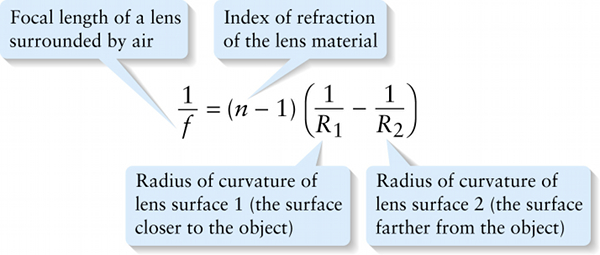Chapter 24. Lensmaker’s equation for the focal length of a thin lens (24-24)
Question
1gbOxJyjY4qI7V4WF2+YcgPWAsaK42fjlXpIZvwH5HnEBRtJZbdal3Scg8A=
Question
RRzyzq7irEN47hOs84E3E/aG6S6lc0TXQpuhlNcVb++Sd/bJC/bHL7pE0d4=
Question
e9n0G5tPjGRR42QyZLfuw5tDD+qVAEhjEqzesDTVfPvKMNLqzDEP4zaA7fPb9JK8HThyTy1Wx2837xd0g+4KWRJxYO1Jczqn5gVk0s+hbJg=
Question
MVhRFHH9pebU5IJLwghCfBKSr0V1RboWW/pUtlM3O/rk7t3d4TnOBAxyZ56kD2hrHIPZcdTqJcZcqxPHCT5LtBSSSs97ugVwAxYB/g==
Review
Equation 24-24 can be derived by applying Snell’s law of refraction (Equation 23-6) to a ray of light refracted by both surfaces of a lens. The derivation is beyond our scope, however.
The values of the radii of curvature \(R_1\) and \(R_2\) depend on how sharply and in what direction the two surfaces of the lens are curved. As Figure 24-34 shows, we take a radius to be positive if the center of curvature is on the other side of the lens from the object, but negative if the center of curvature is on the same side as the object. For example, in Figure 24-34 the radius \(R_1\) of surface 1 is positive, but the radius \(R_1\) of surface 2 is negative.
